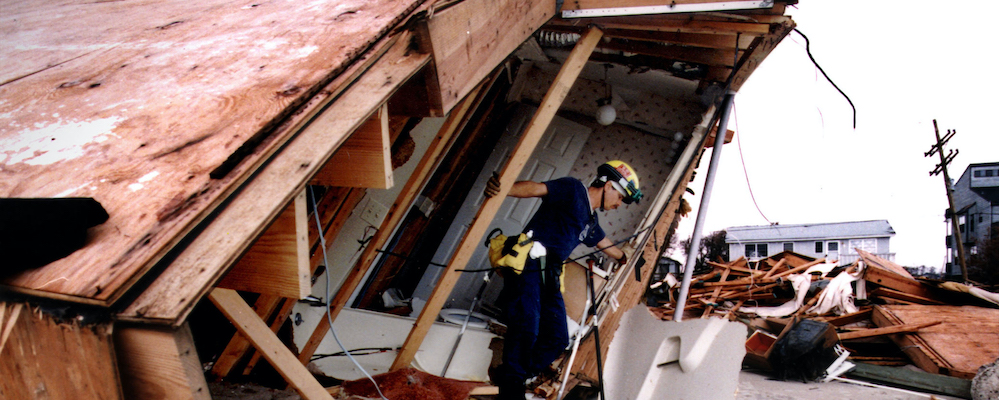 A search and rescue team member explores a North Carolina home damaged by Hurricane Fran in 1996. Source: Dave Gatley/FEMA, 1996.
A search and rescue team member explores a North Carolina home damaged by Hurricane Fran in 1996. Source: Dave Gatley/FEMA, 1996.
Narrowly avoiding a close call with a disaster might make people more likely to evacuate or prepare for the next one. Or it might not. Risk perception can be a fickle concept based in a number of personal factors, but research also shows the nature of that “near miss” plays an important role.
In their 1998 Coastal Management publication, Kirstin Dow and Susan Cutter examined evacuation behavior during Hurricane Bertha and, subsequently, Fran in 1996 to see if they would find a “cry wolf” effect after Bertha missed South Carolina and struck North Carolina instead. Their study ultimately did not find evidence of such an effect and determined that the “premature evacuations” for Bertha in South Carolina only played a minor role in evacuation decisions for Fran.
Building on this seminal research, we further examined the role of near-miss events in individual decision making to prepare—or not—for natural hazards. What we learned was that decision making can be highly nuanced. How people integrate factors including their personal experiences with previous storms and characteristics of the current storm in calculating risk is critical to determine the preparedness actions they might take.
In our work, we define a “near miss” as an event in which a person has a non-trivial expectation of experiencing disaster but, by chance, does not. Our natural environment produces many examples of near misses: a random tree pattern saves a house from a mudslide, for instance, or a hurricane weakens right before it hits a city. What is critical is how people interpret these events because every near-miss event has some plasticity in interpretation—it can be taken as either evidence of the seriousness of the threat or of its irrelevance.
We categorize near misses as either vulnerable (where the avoidance of a disaster results in a perceived vulnerability of the system) or resilient (where avoidance of a disaster results in a perceived resilience of the system). Near-miss events in a context where people escape harm can sometimes seem to imply resiliency because no damage was done. Our research shows that these near-miss experiences can lead to riskier behavior. On the other hand, when people understand a near-miss as a disaster that “almost happened,” rather than a disaster that was avoided, then this could be associated with vulnerability. Our research shows that people who frame their disaster experience as a resilient near miss will be less likely to mitigate against impending hazards than people without this frame.
When a near-miss experience highlights the harm the event could have been caused, however, it adds information that counteracts the basic resilient near-miss effect. That is, a near miss that causes no harm can make the hazard seem less threatening, but the presence of harm creates associations with vulnerability. Thus, people with vulnerable near-miss information (that highlights how an event almost caused harm) will be more likely to take mitigating action for an impending hazard than people with resilient near-miss information.
Consistent with other research in decision making, our results suggest people are heavily influenced by previous outcomes. Past near-miss experiences shape how people explicitly judge risk and take mitigation and preparedness action. Remember, risk is a function of the likelihood of an event and its consequences. We believe the mechanism driving people’s behavior is their perception of danger or the consequences, which stems directly from the influence of a near-miss influence on their memory, rather than a changed assessment of the likelihood of an event.
Finally, previous hazard research has shown that people’s mitigation activity depends, in part, on what their neighbors decide to do. Research that considers how near misses influence group decision making is a logical next step. If some decisionmakers experienced resilient near-misses while others experienced vulnerable near-misses, which one would dominate when these experiences are shared? This research question should be explored further.
Understanding how near-misses impact behavior and decision making is vital to organizations responsible for informing the public about hazards. For example, those who educate the public about natural disasters may assume that people will respond uniformly to facts about the costs and probability of future events.
Our results suggest otherwise. Specifically, the same objective facts about the costs and statistically calculated risk of impending hazards will be evaluated differently by different people depending on their own near-miss experiences. Therefore, such facts may be insufficient for producing action. Instead, the narrative that accompanies these facts (including vulnerable or resilient near-miss information) can impact reactions to hazards. For those who experience resilient near misses, it might also be necessary to supplement information on possible harm to enhance their hazard decision making.
Robin L. Dillon-Merrill is a professor in the McDonough School of Business at Georgetown University. She has received research funding from the National Science Foundation, NASA, the Department of Defense, and the Department of Homeland Security through USC’s National Center for Risk and Economic Analysis for Terrorism Events. She has served as a risk analysis and project management expert on several National Academies Committees including the review of the New Orleans regional hurricane protection projects and the application of risk analysis techniques to securing the Department of Energy’s special nuclear materials. She has bachelors and masters degrees from the University of Virginia in systems engineering and a Ph.D. from Stanford University.